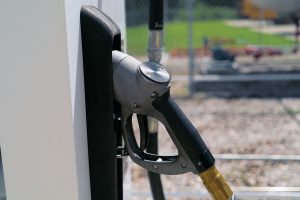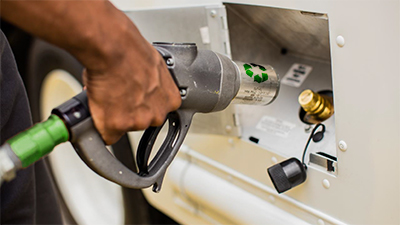Propane as an Automotive Fuel
Propane as an automotive fuel (propane autogas) has a high-octane value and has key properties for spark-ignited internal combustion engines. Propane autogas carries an almost 100-year heritage, with the first propane-based vehicle developed in 1913.
Propane autogas, which has propane as its primary constituent, has the advantages of producing lower emissions, offering more energy per unit mass while having a higher octane rating than gasoline. In addition, through the use of propane autogas we can continue to work away from dependence on foreign sources of domestic energy.
Propane autogas also has the advantage of already having a robust national infrastructure in place to support its implementation not only as an alternative fuel, but also as a primary fuel.
Safety
Propane autogas is considered as safe as any conventional automotive fuel. It is a nontoxic, non-carcinogenic and noncorrosive fuel. It poses no harm to groundwater, surface water, or soil. Since propane is odorless and colorless, an odorant, ethyl mercaptan, is added for leak detection. Propane autogas powered vehicles and their respective fueling systems are designed to perform safely during both normal operations and crash situations. A pressure release device (PRD) is designed to release propane gas if pressure rises in the tank beyond safe levels. Tanks are not filled with more than 80 percent to the total capacity. This ensures there is sufficient room for the liquid to expand when heated or when the ambient temperature rises. Moreover, in any eventuality of a leak the gas escapes into the air and does not remain in the tank like gasoline.
Emissions
Propane is an approved, clean fuel listed in the 1990 Clean Air Act and the Energy Policy Act of 1992. Propane is one of the cleanest burning of all fossil fuels. Tests conducted by the U.S. Environmental Protection Agency (EPA) show that propane autogas fueled vehicles produce 30 percent to 90 percent less carbon monoxide emissions and approximately 50 percent fewer toxins and other smog producing emissions as compared to gasoline engines.
Propane can also provide significant benefits in fighting global climate change. Propane contains less carbon per unit energy than either gasoline or diesel, resulting in significantly lower greenhouse gas (GHG) emissions when burned. Unlike methane (the primary constituent of compressed natural gas), propane is not a GHG when released into the atmosphere.
Conversion Technology
To operate a vehicle on propane autogas as either a dedicated fuel or dual-fuel vehicle (i.e., switching between gasoline and propane), only a few modifications to the vehicle must be made. Until recently, propane autogas powered vehicles have commonly used a vapor pressure system that was somewhat similar to an old carburetor system, wherein the propane would be vaporized and mixed with combustion air in the intake plenum of the engine. This leads to lower engine output, as the vaporized propane displaces air, which would normally be consumed by the engine.
A more recent approach is in the form of multi-port liquid injection that is capable of delivering liquid propane autogas directly into each cylinder’s intake port. Such a system will improve breathing efficiency and thereby lead to overall improved engine performance. When injected in this way, the fuel displaces significantly less air in the engine, and lowers the temperature of the air charge, which increases its density. Because propane autogas does not occupy a significant amount of volume within the intake, the performance of the engine will not be reduced. Furthermore, the fuel will vaporize as it mixes with the air, absorbing energy from the air, lowering the air’s temperature and ultimately increasing its density, again increasing performance. This advantage over a gaseous system eliminates the need for forced induction in order to maintain performance.
The single greatest drawback of a liquid injection system is problems associated with maintaining the propane autogas in a liquid state up to the injectors, given the operational temperature of the engine. This issue is addressed within the ROUSH CleanTech liquid propane autogas fuel system.
ROUSH CleanTech Liquid Propane Autogas Fuel System Overview
The ROUSH CleanTech liquid propane autogas fuel system is a dedicated liquid injected system and completely replaces the OEM fuel system. The conversion process involves removing the OEM fuel tank assembly, the fuel line assembly and the fuel rail assembly. The vehicle then has the ROUSH CleanTech liquid propane autogas fuel system installed on it. An overview of the system hardware can be seen in Figure 1. Note that each application varies somewhat; the system shown is an in-bed tank installation from the 2007.5 to 2008 Ford F-150 application.

Figure 1: ROUSH CleanTech Liquid Propane Autogas Fuel System
The ROUSH CleanTech liquid propane autogas fuel system consists of four major subsystems. A list of these subsystems and their key components can be found in Table 1.
Table 1: ROUSH CleanTech Liquid Propane Autogas Fuel System & Subsystems
Subsystem Description:
Fuel Rail Assembly
The ROUSH CleanTech liquid propane autogas fuel system uses two symmetrical billet aluminum rail halves. Each rail half is fitted with four propane autogas specific fuel injectors. One rail half is fitted with an injection pressure and temperature sensor (IPTS). This sensor contains an OEM spec thermistor and a 0-500 psi pressure transducer.
Fuel Line Assembly
The ROUSH CleanTech liquid propane autogas fuel system features a return fuel system. The return line contains a flow control solenoid, either as a single component (as shown in Figure 2), or incorporated in a multi-function Fuel Rail Pressure Control Module (FRPCM). The flow control solenoid is used by the Powertrain Control Module (PCM) to control fuel pressure in the fuel rail in order to ensure there is liquid propane in the fuel rail. The solenoid is a normally closed solenoid with an orifice drilled between the inlet and outlet ports of the solenoid body to permit some flow back to the tank when the solenoid is closed. When the solenoid is energized, the orifice is bypassed and return fuel flow to the tank is increased. The flow control solenoid can be seen in the upper left corner of Figure 2.

Figure 2: Fuel Rail Assembly and Flow Control Solenoid
Fuel Tank Assembly
The ROUSH CleanTech liquid propane autogas fuel system, as designed for the 2009 and newer Ford E-450 cutaway, will utilize a dual manifold tank and occupies the same vehicle package envelop as the OEM gasoline tank that it replaces. The tanks are manufactured from ductile steel and certified to ASME standards. Refer to Figures 3 & 4.
Figure 3: Ford E-450 Fuel Tank Assembly
Figure 4: Ford E-450 Fuel Tank Assembly as installed in vehicle frame
In order to transfer the liquid propane autogas fuel from the tank to the engine, the fuel tank assembly contains a fuel pump assembly powered by the Powertrain Control Module (PCM) as it would in the OEM gasoline vehicle application.
A total of three fuel filters are used with the fuel tank assembly. One filter is located external to the tank and is contained within the fuel fill line between the tank and fill valve. Two additional filters are located inside of the tank, one at the fuel pump inlet and the other at the fuel pump outlet.
The tank contains a fuel level sender resistor card and a unique fuel level sender float arm designed to match the output profile of the OEM fuel level sender. Internal tank baffles and a jet pump are used to maximize fuel pickup and delivery during low fuel conditions and extreme vehicle dynamic maneuvers.
Tank Safety Features
The OEM vehicle inertia switch is retained as a means to disable fuel pump operation in the event of a collision. Additional safety features contained within the tank assembly itself include an 80 percent fill sensor and stop fill solenoid to eliminate the potential for over filling the tank. A pressure relief valve will vent the tank in the event that tank pressure exceeds 312 psig. An excess flow valve is located within the supply line and is used to detect when an inordinate amount of fuel is being supplied to the system and will immediately stop the flow of fuel. In the event that a line ruptures, these valves prevent the dispersing of fuel directly into the atmosphere.
Figure 5: Ford E-450 Fuel Tank Assembly Cross Section View
POWERTRAIN CONTROL SYSTEM
PCM I/O Devices
Whenever possible the OEM production I/O devices are retained during the LPI conversion.
A list of the I/O devices that are different from the OEM vehicle can be found in Table 2.
| Removed Gasoline Component | Replacement Propane Autogas Component | Functional Differences |
|---|---|---|
| Gasoline Fuel Injector | Propane Autogas Fuel Injector | Unique Slopes and Offsets for Propane Autogas Injectors |
| Injection Pressure and Temperature Sensor (IPTS): 30kΩ Thermistor & 0-90psi Transducer housed in one body | IPTS 10kΩ
Thermistor 0-500psi Transducer housed in one body |
Injection Temperature Sensor and Injection Pressure Transducer Calibration Modified for Increased Range |
|
Fuel Level Sender |
Fuel Level Sender |
Custom Fuel Level Sender Resistor Card/Float Arm to match OEM Sender Output |
|
FTPT |
None |
Part Deleted (Ford F-150, Ford F-250/Ford 350) Retained as vapor system pressure transducer (Ford E-Series, Ford E-350, Ford E-450) |
|
EVMV |
None |
Part Deleted (Ford F-150, Ford F-250/Ford 350) |
|
CANVNT |
None |
Part Deleted (Ford F-150, Ford F-250/Ford 350) |
|
N/A |
Flow Control Solenoid |
See Flow Control Solenoid Description |
|
N/A |
Smart Relay Module (SRM) |
Reads IPTS input on vehicles where gasoline system does not use one; controls flow control and other system relays where gasoline PCM lacks sufficient capability |
Table 2: I/O Changes
PCM Control System Strategy and Calibration
The PCM calibration consists of a modified version of the OEM strategy and a propane autogas specific calibration.
Control System Strategy
The ROUSH CleanTech liquid propane autogas strategy is built off of the OEM strategy with the addition of new logic to drive and monitor the flow control solenoid. Because the strategy is based off of the OEM strategy, the OEM PCM retains all fuel control and diagnostic functions. No modifications are made to the scan tool interface features of the logic except to add the propane autogas specific DTC’s. The propane autogas DTC’s are stored in the PCM memory and are cleared via the OEM strategy’s fault state controller.
Calibration
Changes to the OEM calibration are made in the following areas:
Engine:
- Modified I/O scaling as required
- Modified spark and fueling functions as required by physical properties of propane
- Disabled purge feature
Transmission:
- No changes required
Diagnostics:
- Disable (Ford F-150, Ford F-250 / Ford 350) or modify purge monitor and related component monitors
System Operation & Performance
One of the key benefits of the ROUSH CleanTech liquid propane autogas fuel system is that vehicle operation and performance is virtually transparent as compared to that of the base gasoline vehicle. One of the reasons for this is the fact that there is no loss in engine performance. The following graph shows the engine performance comparison of the Ford 5.4L 3V gasoline engine as used in the 2010 Model Year Ford F-250 / Ford F-350 vehicle both before and after the ROUSH CleanTech fuel system conversion.
Propane as an automotive fuel (propane autogas) has a high-octane value and has key properties for spark-ignited internal combustion engines. Propane autogas carries an almost 100-year heritage, with the first propane-based vehicle developed in 1913.
Propane autogas, which has propane as its primary constituent, has the advantages of producing lower emissions, offering more energy per unit mass while having a higher octane rating than gasoline. In addition, through the use of propane autogas we can continue to work away from dependence on foreign sources of domestic energy.
Propane autogas also has the advantage of already having a robust national infrastructure in place to support its implementation not only as an alternative fuel, but also as a primary fuel.














